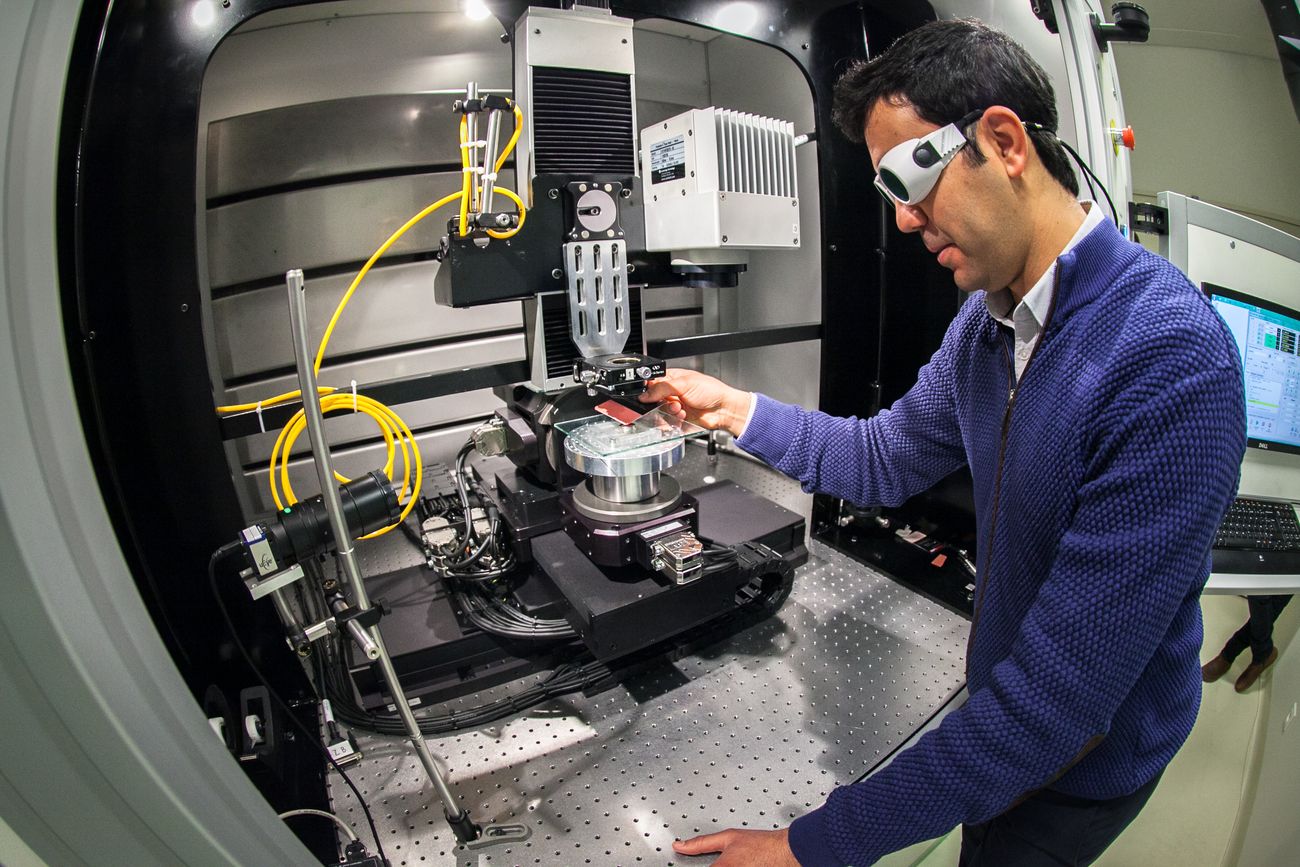A new laser machining technique for industry
 FEMTO-Engineering, part of Carnot Télécom & Société numérique institute, offers manufacturers a new cutting and drilling technique for transparent materials. By using a femtosecond laser, experts can reach unrivalled levels of precision when manufacturing ultra-hard materials. Jean-Pierre Goedgebuer, director of FC’Innov (FEMTO-Engineering), explains how the technique works.
FEMTO-Engineering, part of Carnot Télécom & Société numérique institute, offers manufacturers a new cutting and drilling technique for transparent materials. By using a femtosecond laser, experts can reach unrivalled levels of precision when manufacturing ultra-hard materials. Jean-Pierre Goedgebuer, director of FC’Innov (FEMTO-Engineering), explains how the technique works.
What is high aspect ratio precision machining and what is it used for?
Jean-Pierre Goedgebuer: precision machining is used in cutting, drilling and engraving materials. It allows various designs to be inscribed onto materials such as glass, steel or stainless steel. It’s a very widespread method in industry. Precision machining corresponds to a positioning and shaping technique for an extremely small scale, i.e. in the range of 2 microns (10-6 meters). The term “aspect ratio” for example is a reference to drilling. It corresponds to the relationship between the depth and the diameter. Therefore, an aspect ratio of 100 corresponds to a diameter 100 times smaller than its depth.
Cutting or drilling requires local destruction and mastery of the material. In order to achieve this, we supply energy from a laser. This emits heat when it comes into contact with the material.
What is femtosecond machining?
JPG: The term femtosecond [1] refers to the duration of the laser pulses, which last a few tens or hundreds of femtoseconds. The length of the pulse determines the length of the interaction between light and the material. The shorter it is, the fewer thermal exchanges there are with the material and therefore in principal, the less the material is destroyed.
In laser machining, we use short pulses (femtoseconds – 10-15 of a second) or longer pulses (nanoseconds – 10-9 of a second). The choice depends on the usage. For machining with no thermal effect, that is, where the material is not affected by the heat produced by the pulse, we tend to use femtosecond pulses, allowing us to find a good compromise between destruction of the material and how high the temperature is. These techniques are associated to light propagation models which allow us to simulate the impact of the properties of a material on the propagation of the light going through it.
The femtosecond machining technique generally uses Gaussian beams. The defining characteristic of your process is that it uses Bessel beams. What is the difference?
JPG: Gaussian laser beams are beams inside which the energy is spread in a Gaussian way. When they have raised energy levels, they produce non-linear effects when propagated in the materials. This means that they produce autofocusing effects, making their diameters non-constant and distorting their propagation. These effects can be detrimental to the quality of the machining of certain special kinds of glass.
In contrast, the Bessel laser beams, like what we use in our machining technique, allow us to avoid these non-linear effects. They therefore have the ability to maintain a constant diameter over a well-defined length. They act as very fine “laser needles”, measuring just a few hundred nanometers in diameter (a nanometer corresponds to approximately the size of an atom). Inside these “laser needles” is a very high concentration of energy. This generates an extremely localized plasma within the material, which causes the excision of the material. Furthermore, we can control the length of these “laser needles” in a very precise way. We use them to do very deep cutting or drilling (with an aspect ratio of up to 2,000) producing a precise, clean result with no thermal effects.
In order to start being able to use this new technology, we used a traditional femtosecond laser. What led to several patents being filed by the Institut FEMTO-ST, was finding out how to transform Gaussian beams into Bessel beams.
What is the point of this new technology?
JPG: There are two main reasons for it. As we’re dealing with “laser needles” which hold a high density of energy, it is possible to drill very hard materials which would pose a problem for traditional laser machining techniques. Thanks to the technique’s athermic nature, the material in question keeps its physicochemical properties intact; it does not change.
This machining method is used for transparent materials. Industrial demand is high as there are many products that require the machining of herder transparent materials. This is the case for example with smartphones, where the screens need to be made from special kinds of very durable, scratch-resistant glass. This is a big market and is a major focus for many laser manufacturers, particularly in Europe, the US and of course, Asia. There are several other uses however, including elsewhere in the biomedical field.
What’s next for this technique?
JPG: Our mission at FEMTO Engineering is to accentuate the research coming out of the Institut FEMTO-ST. In this context, we have partnerships with manufacturers with whom we are exploring how this new technology could respond to their needs in terms of very specific materials where traditional femtosecond machining doesn’t give satisfactory results. We are currently working on cutting new materials for smartphones, as well as polymers for medical use.
The primary research carried out by the Institut FEMTO-ST, is continuing to focus in particular on better understanding light-matter interaction mechanisms and plasma formation. This research was recently formally recognized by the ERC (European Research Council) which finances experimental projects that encourage scientific discovery. The aim is to really master the understanding of the physical properties of Bessel beam propagation which is something that has not been particularly studied on a scientific level before now.
[1] A femtosecond corresponds to one millionth of a billionth of a second. It’s the approximate duration of an electromagnetic wave. A femtosecond is to a second what a second is to the lifetime of the universe.
On the same topic:





Leave a Reply
Want to join the discussion?Feel free to contribute!